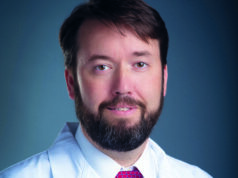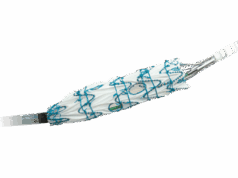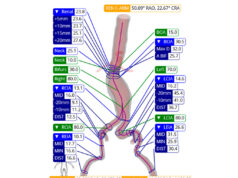 The twin issues of center volumes for open AAA repair as well as training implications came under the spotlight at two recent regional vascular conferences.
The twin issues of center volumes for open AAA repair as well as training implications came under the spotlight at two recent regional vascular conferences.
The volume of elective open abdominal aortic aneurysm (AAA) repairs that medical centers perform directly correlates with the outcome measure “failure to rescue,” or in-hospital death after a patient experiences a complication—with a nearly 10% decreased risk evident for each additional five cases per year an institution performs, the New England Society for Vascular Surgery (NESVS) annual meeting (Oct. 15–17) in Cape Neddick, Maine heard.
The findings were part of an analysis of all elective open AAA repair procedures included in the Society for Vascular Surgery (SVS) Vascular Quality Initiative (VQI) between 2003 and 2020.
Against a backdrop of debate over the annual center volume-mortality relationship and varying minimum procedure volume recommendations, the researchers behind the VQI study identified failure to rescue as “an attractive alternative outcome measure” due to the fact it judges overall team and hospital system performance, and is a composite measure, therefore “is less sensitive to risk-adjustment errors and may further improve discriminations for inter-hospital quality comparisons.”
The work was led by senior author David H. Stone, MD, a professor of surgery and program director at Dartmouth-Hitchcock Medical Center in Lebanon, New Hampshire, and Salvatore Scali, MD, a professor of surgery and program director at the University of Florida in Gainesville, Florida, who delivered the findings before the NESVS meeting.
The team set out to measure the impact of failure to rescue on elective open AAA repair outcomes and its association with center volume, as well as to determine the factors associated with failure to rescue. The analysis was performed on data from 218 VQI hospitals. Some 9,700 open repairs were retrieved, with 32% found to have at least one postoperative in-hospital complication recorded. Among the 3,176 patients experiencing a complication, 10% died in hospital—representing the failure-to-rescue cohort, Scali explained.
“We determined that older patients, and women, as well as subjects with higher comorbidity burden, larger AAA diameters, and any history of prior aortic surgery were all significantly more likely to be present among the failure-to-rescue cohort,” Scali told those gathered. Technical differences were also noted between the two groups, he added. Recommended adjuncts including decreased epidural use occurred in the failure-to-rescue cohort, while variables associated with greater operative complexity and greater blood loss were more common among the same group.
Unadjusted analysis showed center volume was inversely associated with failure-to-rescue rates: There was a 9% decrease in risk for each additional five procedures per year a center performed, Scali said. Some 73% of VQI centers performed less than 10 open repairs per year—the current SVS-endorsed volume threshold. Yet, Scali pointed out, they accounted for around a third of all open AAA repairs nationally.
“When adjusting for demographics, comorbidities and procedure-related factors, patients undergoing elective open AAA repair at centers performing more than 10 AAA repairs per year had a 50% reduction in the likelihood of experiencing failure to rescue,” he continued.
When exploring the association between the number of postoperative complications and subsequent probability of failure to rescue, “significant differences” were detected. For example, if a patient experienced two postoperative complications, they had a more than three-fold likelihood of experiencing failure to rescue compared to a patient suffering a single complication, the researchers found.
“This difference is further amplified when looking at patients experiencing two vs. three or more complications,” Scali said. “Specifically, a seven-fold increase in predicted risk of failure to rescue occurred in patients experiencing three or more complications when compared to those cataloged as having two complications. Finally, the difference between a single complication and three or more complications was exponential, with a 24-fold relative risk increase being present.”
In terms of specific types of complications and the predicted risk of failure to rescue, Scali and colleagues found that renal complications had the lowest predicted rate. By comparison, a postoperative cardiac complication had a nearly three-fold higher risk, while a return trip to the operating room (OR) for bleeding was associated with a nearly 12-fold increased risk compared to a renal complication.
“Center volume does appear to be an effective proxy for quality given its strong association with failure to rescue,” Scali concluded. “A majority of centers fail to meet SVS-endorsed volume thresholds, which may have implications for outcome reporting and inter-hospital comparisons. Crude volume-based comparisons alone may be suboptimal in discerning high-quality AAA care among centers nationally.”
Context of failure to rescue
In an interview with Vascular Specialist, Scali said the varying open repair volume thresholds posed for optimal care begged the question: “Is there a better way?” Regionalization of aortic care, while worthy, works in small countries with single-payor systems and “relatively monochromatic societies,” but less so in continental-sized countries and markets in the form of the U.S., he said.
Furthermore, there are low-volume centers “that perform well, that don’t meet the thresholds” but on average can deliver quality care, Scali continued. “How do you align so that when you go to a lower-volume hospital, you know you are going to get high-quality care? How do you make the lower-volume centers look like the higher-volume centers?”
That’s where failure to rescue comes in, Scali said. “There are so many ancillary services required, and, most importantly, that postoperative care—the surveillance that occurs both in-hospital and out-of-hospital—and having robust processes of care are probably the biggest determinants of the outcome.” Surgeon-level factors, too are important, “but if you really want to align these lower-volume hospitals with higher-volume hospitals you have to target metrics that measure team performance.”
These new results help characterize patterns of complications—particularly those deemed high risk, Scali added. “Where [our study] sheds new light—yes, the volume-outcome relationship is known—is that failure to rescue further validates this based on our dataset. But, more importantly, if low-volume centers are going to continue to do this work, they might want to develop processes of care that target very high-impact complications, for one.
“As we’ve shown in our work, things like a return to the OR for bleeding, or patients who have a postoperative pulmonary complication, to name a couple of high-profile complications; those are key patients that, when those complications occur, are at the highest risk of having a downstream event that leads to failure to rescue and in-hospital death. So, you would want to do everything you can to reduce the risk of those events. And if those events did occur, those are where the resources in these low-volume hospitals need to be focused.”
Future of open aortic education
At the Western Vascular Society (WVS) annual meeting (Oct. 16–19) in Jackson Hole, Wyoming, meanwhile, a research team from Stanford University, California, presented data on the future of open aortic education, finding that with the incidence of open AAA repair decreasing nationally, practice shifting toward teaching hospitals, and opportunities for training declining amid the continuing adoption of endovascular aneurysm repair (EVAR), “open aortic reconstruction for aortoiliac occlusive disease is rising among trainees.”
Delivering the results, Stanford vascular surgery chief resident Elizabeth George, MD, told WVS attendees: “Just from our back-of-the-envelope calculations and looking at national volumes, these aortic volumes, at least from those at teaching hospitals, are adequate to meet graduation requirements. However, strategies to maintain and maximize the education as well as the experience from these cases should be top priority for vascular surgery program directors.”
George and colleagues set out to explore how evolving endovascular technology has transformed open aortic surgical education. To do so, they probed the National Inpatient Sample (NIS) for open AAA repair as well as aortoiliac occlusive disease estimates between 2006 and 2017. They also looked at Accreditation Council for Graduate Medical Education (ACGME) case volumes for the same procedures among vascular surgery residents and fellows graduating during the same time period. In the NIS, George and colleagues found significant decreases in volume for both total open aortic repair volume and open AAA, with open repair for aortoiliac reconstruction seeing a far less steep decline. Meanwhile, the ACGME data showed that in 2006, graduating fellows could claim an average of 19 open AAA repairs, George reported. However, this figure had dropped to 11 by 2017. On the other hand, the equivalent statistic for aortoiliac occlusive disease increased over the same time span, she said. Data derived for those in integrated vascular surgery residency told a similar story, she added.
‘Refreshing’ data
Designated discussant Benjamin W. Starnes, MD, the vascular surgery chief at the University of Washington in Seattle, called the data presented by George and colleagues a “refreshing” interlude amid previous forecasts spelling out “doom and gloom” in light of vascular trainees not gaining enough open surgical experience in order to achieve competency. “Facing an increase in vascular disease, an aging population and the silver tsunami, better cancer therapies and patients surviving longer to develop vascular disease, and more minimally invasive methods to treat these patients, we’ve now grown at the University of Washington from six to 16 vascular surgeons in just 15 years,” he said. “Our open experience has only increased for our trainees rather than decreased.”
Starnes placed this into context with data from his institution for the last year: He found that 38% of the aortic cases with which he was personally involved were open repairs, and went on to ask George how other types of exposures should be counted toward open aortic surgery for the ACGME.
“Since vascular surgery itself has evolved over the past 20 or 30 years, I think the metrics with which we measure our trainees should also change in kind,” she said.












